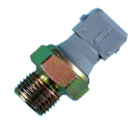-
Warns the driver if the oil pressure in the engine becomes too low
Troubleshooting:
-
Symptoms:
-
Oil pressure gauge fluctuates irregularly or fails to register a reading
-
Possible causes for failure:
-
Circuit broken between sensor and ECU
-
Damaged wire connector
Testing:
To test the oil pressure switch, disconnect it from its electrical connectors. Ensure that the ignition is turned off before disconnecting.
-
Check surrounding wires for corrosion and damage and ensure that a current is being sent to the switch by connecting a voltmeter to the electrical connectors.
-
Secondly, check the resistance of the part. For this you will need to remove the connector wire from the end of the switch. Take one lead from the multimeter and attach it to the sensor’s connector. Ground the other lead against the engine block. When the ignition is turned on, the multimeter reading should rise to around 100 ohm. If the reading is substantially more or less then this is a good indication that the switch is faulty.
-
If the problem is not solved following steps 1 and 2, you should investigate the required oil pressure for the vehicle which will need to be established from the vehicles manual.
Common Fault Codes
-
P0520 Engine Oil Pressure Sensor/Switch Circuit Malfunction
-
P0521 Engine Oil Pressure Sensor/Switch Circuit Range/Performance
-
P0522 Engine Oil Pressure Sensor/Switch Circuit Low Voltage
-
P0523 Engine Oil Pressure Sensor/Switch
